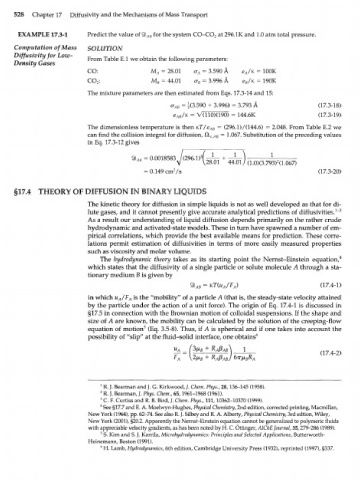Page 548 - Bird R.B. Transport phenomena
P. 548
528 Chapter 17 Diffusivity a n d the Mechanisms of Mass Transport
EXAMPLE 173-1 Predict the value of ЯЬ for the system CO-CO at 296.1K and 1.0 atm total pressure.
2
АВ
Computation of Mass SOLUTION
Diffusivity for Low-
_ JJ . jf J From Table E.I we obtain the following parameters:
Density Gases
СО: М == 28.01 a = 3.590 A S A/K = 100K
А A
СО : М == 44.01 a = 3.996 A S B/K = 190K
2 в B
The mixture parameters are then estimated from Eqs.17.3-14 and 15:
= ^(3.590 + 3.996) = 3.793 A
O'AB (17.3-18)
£AR/* : = V(110)(190) = 144.6K (17.3-19)
The dimensionless temperature is then кТ/е АВ = (296.1)/(144.6) = 2.048. From Table E.2 we
can find the collision integral for diffusion, CL = 1.067. Substitution of the preceding values
lfAB
in Eq. 17.3-12 gives
2
= 0.149 cm /s (17.3-20)
§17.4 THEORY OF DIFFUSION IN BINARY LIQUIDS
The kinetic theory for diffusion in simple liquids is not as well developed as that for di-
1 3
lute gases, and it cannot presently give accurate analytical predictions of diffusivities. "
As a result our understanding of liquid diffusion depends primarily on the rather crude
hydrodynamic and activated-state models. These in turn have spawned a number of em-
pirical correlations, which provide the best available means for prediction. These corre-
lations permit estimation of diffusivities in terms of more easily measured properties
such as viscosity and molar volume.
The hydrodynamic theory takes as its starting point the Nernst-Einstein equation, 4
which states that the diffusivity of a single particle or solute molecule A through a sta-
tionary medium В is given by
®AB = KT(U /F ) (17.4-1)
A
A
in which u /F A is the "mobility" of a particle A (that is, the steady-state velocity attained
A
by the particle under the action of a unit force). The origin of Eq. 17.4-1 is discussed in
§17.5 in connection with the Brownian motion of colloidal suspensions. If the shape and
size of A are known, the mobility can be calculated by the solution of the creeping-flow
equation of motion 5 (Eq. 3.5-8). Thus, if A is spherical and if one takes into account the
possibility of "slip" at the fluid-solid interface, one obtains 6
u A
K
F A '
1 R. J. Bearman and J. G. Kirkwood, /. Chem. Phys., 28,136-145 (1958).
2 R. J. Bearman, /. Phys. Chem., 65,1961-1968 (1961).
3 С F. Curtiss and R. B. Bird, /. Chem. Phys., I l l , 10362-10370 (1999).
4 See §17.7 and E. A. Moelwyn-Hughes, Physical Chemistry, 2nd edition, corrected printing, Macmillan,
New York (1964), pp. 62-74. See also R. J. Silbey and R. A. Alberty, Physical Chemistry, 3rd edtion, Wiley,
New York (2001), §20.2. Apparently the Nernst-Einstein equation cannot be generalized to polymeric fluids
with appreciable velocity gradients, as has been noted by H. C. Ottinger, AIChE Journal, 35,279-286 (1989).
5 S. Kim and S. J. Karrila, Microhydrodynamics: Principles and Selected Applications, Butterworth-
Heinemann, Boston (1991).
H. Lamb, Hydrodynamics, 6th edition, Cambridge University Press (1932), reprinted (1997), §337.
6

